
TIA
- 1. (TIA) Harry Haynes Transient Ischaemic Attack
- 2. Definition • A TIA is an acute loss of neurological function caused by ischaemia with symptoms lasting minutes – hours (by definition, <24hrs). • Annual incidence of 3/10 000. • Occur in 10% of patients prior to the development of a stroke.
- 3. Pathogenesis • A TIA is caused by artery-to-artery emboli (ie ulcerated atheromatous plaque debris from the proximal neck vessels) or cardiac emboli ………?
- 4. Pathogenesis • TIAs are usually the result of microemboli • TIAs may be caused by a fall in cerebral perfusion (dysrhythmia, postural hypotension, decreased flow through vital atheromatous arteries) • Rarely, SOL and subdural haematomas cause episodes indistinguishable from thromboembolic TIAs • Increased total red cell volume (polycythaemia) may also be causative
- 5. Risk factors Risk factor Stroke risk Hypertension x5 High cholesterol x4 Smoking, alcohol x2 Diabetes x2 +ve family history AF, IHD, Pill (prog-oes), obesity Internal carotid stenosis
- 6. Clinical Features • Since episodes are transient, the diagnosis is made on the basis of the history • Onset: rapid (seconds – minutes) • Variable (but full) resolution (<24 hrs) • Different clinical disturbances can occur depending on whether the attack involves the anterior or posterior circulation • TIA in anterior circulation has a more serious prognosis
- 7. Anatomy (we all love JRT)
- 8. Clinical Features Anterior Circulation TIAs: Amaurosis fugax (fleeting blindness) – loss of vision in 1 eye • ‘like a shutter coming down’ • Often due to the passage of emboli through retinal artery • May be first clinical evidence of internal carotid artery stenosis
- 9. Clinical Features Anterior Circulation TIAs: Aphasia : loss of ability to use language (common) Dominant parietal lobe TIAs (affecting supramarginal gyrus) may cause difficulty understanding writing (dyslexia) or impairment of writing ability (dysgraphia)
- 10. Clinical Features Posterior Circulation TIAs: • Homonymous visual field loss • Dysarthria • Vertigo, diplopia, dysphagia (rarely TIAs if in isolation) • Tetraparesis • Transient global amnesia (unknown path)
- 11. Clinical Features Anterior OR posterior circulation TIAs: • Unilateral weakness affecting the face, arm or leg in isolation or combination • Unilateral sensory loss affecting the face, arm or leg in isolation or combination TIAs rarely lead to an alteration of consciousness. If this occurs, an alternative diagnosis should be considered
- 12. Examination • Usually reveals no neurological abnormalities post TIA • CVS exam may elicit relevant signs: • Hypertension, retinal changes, arrhythmias, heart murmur, HF signs, carotid bruits, loss of peripheral pulses
- 13. Differential Diagnosis Usually a TIA is clear-cut and a confident diagnosis can be made. Similar symptoms may be produced by: • Migraine: slower progression with positive symptoms and headache • Partial seizures: shorter with similar recurrence • Hypoglycaemia: does produce similar transient neuro deficits • Peripheral nerve lesions: have characteristic symptoms and signs
- 14. Investigation • Routine bloods for polycythaemia (FBC), glucose, U&E, random cholesterol, infection, vasculitis, thrombophilia, syphilitic serology, clotting studies, autoantibodies • CXR, ECG • Carotid Dopplers • Angiography • In those patients where the differential diagnosis includes a SOL or partial seizures, head CT or MRI is indicated
- 15. Secondary Prevention of TIA [Primary Prevention of Stroke] • Control of hypertension reduces stroke rate by 40% • Control of diabetes, stopping smoking, moderating alcohol intake and control of hypercholesterolaemia all reduce atheroma progression • This reduces stroke risk, CAD and MI (the most common cause of death post stroke)
- 16. Management Antiplatelet Therapy • Aspirin 300mg daily should be given as soon as the diagnosis of thromboembolic TIA is confirmed, reducing to 75mg after several days • Long-term 75mg aspirin daily substantially reduces the risk of further infarction after thromboembolic TIA (by 25%)
- 17. Management Antiplatelet Therapy • Combined aspirin 75mg daily and dipyridamole 200mg twice daily () is probably the best prophylaxis against further thromboembolic TIA • Dipyridamole inhibits platelet phosphodiesterase which increases cAMP and potentiates the action of PGI2 • Clopidogrel seems to have same benefit as aspirin alone
- 18. Management Anticoagulants • Should be considered if px has AF, mitral stenosis, recent MI, cardiomyopathies, other dysrhythmias • With TIA with AF, the risk of future stroke is reduced from 12% yr-1 to 4% with anticoagulation to an INR of 2-3 • The risk of future stroke should be balanced against the risk of falls, GI bleed risk, compliance and treatment monitoring
- 19. Management Internal Carotid endarterectomy • Recommended in TIA patients who have internal carotid stenosis >70% • Successful surgery reduces the risk of further TIA/stroke by ~75% • Surgical mortality is 3% • Percutaneous transluminal angioplasty (stenting) is an alternative proceedure
- 20. Prognosis • The risk of stroke and MI is ~7% per year • The risk of stroke is 12% in the first year and 10% subsequently if carotid stenosis >70% • Mortality is ~3x that of a TIA-free matched population
- 21. Summary • Diagnosis of TIAs depends on the history • ~10% of patients have a TIA before having a stroke • Management depends on understanding the pathophysiology of TIAs • Management includes the use of antiplatelet agents, anticoagulation or carotid endarterectomy